How to choose a dynamic balancing machine for crankshaft dynamic balancing detection?


Among the 36 machining processes of automobile engine crankshafts, crankshaft dynamic balancing machining is listed as a key machining process. Poor precision in dynamic balancing machining can lead to excessive vibration during vehicle operation, affecting driving stability and even causing crankshaft fracture and safety accidents. The development of dynamic balance testing technology and signal processing technology is rapid. Although a series of checks, adjustments, and comparisons have been made in machining, the dynamic balance stability of the crankshaft is still not good enough. Further investigation is needed to identify the causes of measurement stability and seek new solutions.
How to choose a dynamic balancing machine for crankshaft during dynamic balancing testing? The differences in working principles between soft support and hard support dynamic balancing machines inevitably result in differences in their structures and operating methods, leading to their respective advantages and disadvantages. Therefore, careful analysis is necessary when selecting. Some balancing tasks require the use of soft supports, some require hard supports, some soft supports are better, and some hard supports have more obvious advantages.
1. For large-scale production of light and small curved shafts, the specifications of the balanced crankshaft are generally limited, and it is already known when purchasing the balancing machine. At this time, it is advisable to choose a soft support balancing machine, which has the advantage of high sensitivity. The parasitic mass impact has been controlled by the manufacturer within a range that does not affect accuracy. The limited group calibration data can be stored in the measuring instrument, and the operator can use it as if it were a permanent calibration.
2. For large-scale production of crankshafts with a certain weight, the characteristic is that the rotor specifications are relatively small and well known, but higher impact resistance is required. In this case, a hard support balancing machine should be used, but it should work beyond the permanent calibration range, close to the resonance zone (also known as a semi-rigid balancing machine). At this time, high sensitivity can be obtained, and it has the advantages of strong structure and high reliability.
3. Most of them belong to the production or maintenance of single or small batch crankshafts, and there are many specifications and varieties of rotors that need to be balanced, which cannot be determined in advance. In this case, a universal crankshaft dynamic balancing machine is needed. At this point, the hard supported balancing machine has its unique advantages. Its advantages such as permanent calibration, allowing for large initial unbalance, and high reliability can be fully utilized.
We advocate learning from the mechanical design and production concepts of Germany and Japan. We now have a professional technical research and development team that can improve and transform equipment technology based on users' existing dynamic balancing machines. We can also provide customized non-standard dynamic balancing machines according to users' special workpiece needs.
Our dynamic balancing equipment's core components are made of high-quality electronic components and imported parts, which better ensure the stability and service life of the dynamic balancing equipment, and better guarantee the high standard requirements of product quality. Localized production has better reduced the transportation and maintenance costs of imported equipment, and also enabled users to purchase the most practical products with the most economical investment, thus making our products more competitive in the market. If you need a dynamic balancing machine, please feel free to contact our technical customer service for consultation at any time.


Among the 36 machining processes of automobile engine crankshafts, crankshaft dynamic balancing machining is listed as a key machining process. Poor precision in dynamic balancing machining can lead to excessive vibration during vehicle operation, affecting driving stability and even causing crankshaft fracture and safety accidents. The development of dynamic balance testing technology and signal processing technology is rapid. Although a series of checks, adjustments, and comparisons have been made in machining, the dynamic balance stability of the crankshaft is still not good enough. Further investigation is needed to identify the causes of measurement stability and seek new solutions.
How to choose a dynamic balancing machine for crankshaft during dynamic balancing testing? The differences in working principles between soft support and hard support dynamic balancing machines inevitably result in differences in their structures and operating methods, leading to their respective advantages and disadvantages. Therefore, careful analysis is necessary when selecting. Some balancing tasks require the use of soft supports, some require hard supports, some soft supports are better, and some hard supports have more obvious advantages.
1. For large-scale production of light and small curved shafts, the specifications of the balanced crankshaft are generally limited, and it is already known when purchasing the balancing machine. At this time, it is advisable to choose a soft support balancing machine, which has the advantage of high sensitivity. The parasitic mass impact has been controlled by the manufacturer within a range that does not affect accuracy. The limited group calibration data can be stored in the measuring instrument, and the operator can use it as if it were a permanent calibration.
2. For large-scale production of crankshafts with a certain weight, the characteristic is that the rotor specifications are relatively small and well known, but higher impact resistance is required. In this case, a hard support balancing machine should be used, but it should work beyond the permanent calibration range, close to the resonance zone (also known as a semi-rigid balancing machine). At this time, high sensitivity can be obtained, and it has the advantages of strong structure and high reliability.
3. Most of them belong to the production or maintenance of single or small batch crankshafts, and there are many specifications and varieties of rotors that need to be balanced, which cannot be determined in advance. In this case, a universal crankshaft dynamic balancing machine is needed. At this point, the hard supported balancing machine has its unique advantages. Its advantages such as permanent calibration, allowing for large initial unbalance, and high reliability can be fully utilized.
We advocate learning from the mechanical design and production concepts of Germany and Japan. We now have a professional technical research and development team that can improve and transform equipment technology based on users' existing dynamic balancing machines. We can also provide customized non-standard dynamic balancing machines according to users' special workpiece needs.
Our dynamic balancing equipment's core components are made of high-quality electronic components and imported parts, which better ensure the stability and service life of the dynamic balancing equipment, and better guarantee the high standard requirements of product quality. Localized production has better reduced the transportation and maintenance costs of imported equipment, and also enabled users to purchase the most practical products with the most economical investment, thus making our products more competitive in the market. If you need a dynamic balancing machine, please feel free to contact our technical customer service for consultation at any time.
79 browse
